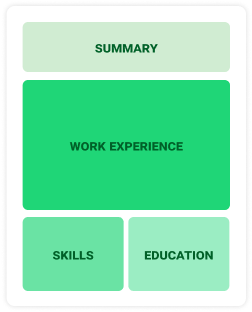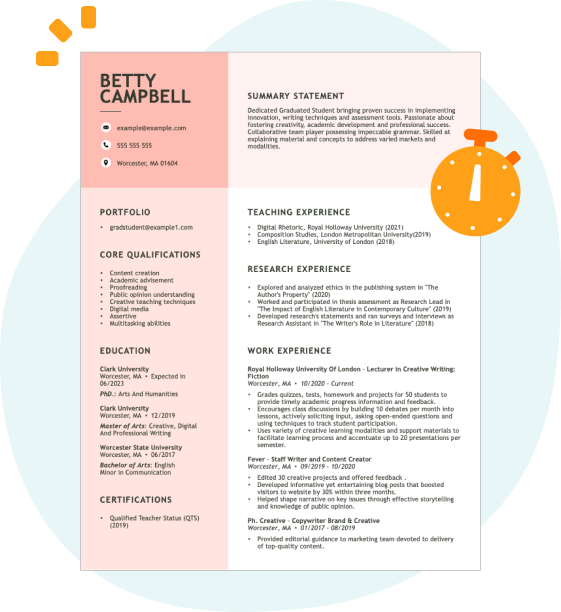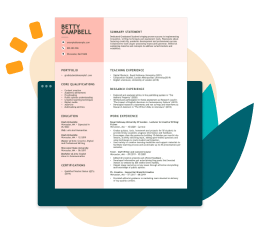Hard skills include expertise in social media management, data analysis, and community engagement strategies that help build a vibrant online presence.
Popular Community Manager Resume Examples
Check out our top community manager resume examples that emphasize key skills such as engagement strategy, content creation, and audience analysis. These examples will help you showcase your accomplishments effectively to potential employers.
Ready to build a standout resume? Our Resume Builder offers user-friendly templates specifically designed for community management professionals, making your job application process smoother.
Entry-level community manager resume
This entry-level resume effectively highlights the job seeker's achievements in community engagement and strategic growth through relevant roles. It showcases their ability to manage events and foster online interactions. New professionals must illustrate their capacity for fostering connections and driving engagement even with limited experience, emphasizing transferable skills from previous roles and academic accomplishments.
Mid-career community manager resume
This resume clearly articulates key qualifications through measurable achievements in community engagement and digital marketing. The strategic presentation of skills demonstrates the job seeker's readiness for advanced roles, showcasing a successful career trajectory and strong leadership potential.
Experienced community manager resume
This resume's work history section demonstrates the applicant's strong capabilities as a community manager, highlighting a 35% increase in community growth and a 50% improvement in engagement rates. The clear formatting facilitates quick recognition of these effective achievements for potential employers.
Resume Template—Easy to Copy & Paste
Daniel Smith
San Diego, CA 92117
(555)555-5555
Daniel.Smith@example.com
Professional Summary
Dynamic Community Manager skilled in increasing engagement and visibility. Proven track record in leveraging social platforms to drive brand growth. Strategic thinker experienced in content creation and SEO optimization.
Work History
Community Manager
ConnectHub Networks - San Diego, CA
January 2023 - November 2025
- Increased engagement rate by 30% via social campaigns
- Built community strategy increasing followers by 20,000
- Managed a team of 5 community associates effectively
Social Media Coordinator
Vibrant Marketing Solutions - San Diego, CA
January 2018 - December 2022
- Boosted audience retention by 25% through content updates
- Led rebranding efforts enhancing brand visibility by 40%
- Increased organic reach monthly by 15% using analytics
Digital Engagement Specialist
SocialPulse Ventures - San Francisco, CA
January 2015 - December 2017
- Developed community guidelines achieving 95% compliance
- Implemented SEO strategies raising site traffic by 60%
- Engaged users through digital tools increasing feedback
Languages
- Spanish - Beginner (A1)
- French - Intermediate (B1)
- German - Beginner (A1)
Skills
- Community Engagement
- Social Media Strategy
- Content Creation
- Brand Awareness
- Community Building
- SEO Optimization
- Data Analysis
- Conflict Resolution
Certifications
- Certified Community Manager - Community Management Institute
- Advanced Social Media Strategy - HubSpot Academy
Education
Master of Arts Communication Management
University of Wisconsin-Madison Madison, Wisconsin
May 2014
Bachelor of Science Marketing
Illinois State University Normal, Illinois
May 2012
How to Write a Community Manager Resume Summary
Your resume summary is the first impression employers have of you. This section should clearly demonstrate your ability to fulfill and surpass the needs of the community manager position.
As a community manager, it’s essential to highlight your skills in communication, engagement, and strategic planning. Showcasing your experience in building relationships and fostering community will set you apart.
To guide you further, here are some examples that illustrate effective strategies for crafting a compelling resume summary. These examples will clarify what works well and what doesn’t:
Weak resume summary
I am a community manager with experience in managing online communities and engaging users. My goal is to find a position where I can use my skills to improve community interactions and contribute positively. I hope to work for a company that values teamwork and offers chances for personal development.
- Lacks specific examples of achievements or skills relevant to community management
- Overemphasizes personal desire instead of highlighting the value brought to the organization
- Uses generic phrases which do not set the applicant apart from others in similar roles
Strong resume summary
Proactive community manager with over 4 years of experience in building and engaging online communities across various social media platforms. Successfully increased user engagement by 30% through targeted content strategies and community events, while growing follower base by 50%. Proficient in social media analytics, content creation, and fostering relationships with stakeholders to improve brand loyalty.
- Starts with specific experience level and role focus
- Cites quantifiable achievements that demonstrate significant impact on community growth and engagement
- Highlights relevant skills that align with the responsibilities of a community manager
PRO TIP
Showcasing Your Work Experience
The work experience section is important for your resume as a community manager, as it typically contains the bulk of your content. Good resume templates always incorporate this important section.
This area should be organized in reverse-chronological order, showcasing each role you've held. Use bullet points to highlight your achievements and contributions effectively in each position.
To help you visualize what works best, we’ve prepared a couple of examples that demonstrate strong work history entries for community managers. These examples will clarify what to include and what to avoid.
Community Manager
Social Media Solutions – Los Angeles, CA
- Managed social media accounts
- Posted updates and interacted with followers
- Answered comments and messages
- Organized online events
- Lacks specific details about strategies or tools used
- No mention of results or improvements made to community engagement
- Focuses on routine tasks without highlighting unique contributions
Community Manager
Belmont Community Services – Austin, TX
March 2020 - Present
- Develop and implement community engagement strategies that increased participation in events by 40% over one year
- Foster relationships with local organizations, resulting in partnership growth of 30%, improving resource availability for community members
- Lead a team of volunteers to organize outreach programs, achieving a 50% increase in service usage within the first six months
- Uses action verbs to clearly convey achievements and impact on the community
- Includes specific metrics that highlight measurable success and effectiveness
- Demonstrates relevant skills such as leadership and relationship-building important for a community manager
While your resume summary and work experience are important, don’t overlook the importance of other sections. Each part plays a role in showcasing your skills and qualifications. For more detailed guidance on crafting an effective resume, refer to our comprehensive guide on how to write a resume.
Top Skills to Include on Your Resume
A well-structured skills section is important for any resume, as it serves as a snapshot of your qualifications. It allows potential employers to quickly identify if you possess the right abilities for the community manager role.
Employers look for professionals who combine specialized expertise with strong interpersonal and collaboration skills. Highlighting both hard and soft skills on your resume shows you can achieve results while working effectively with others.
Soft skills encompass strong communication, empathy, and conflict resolution abilities that foster relationships and promote collaboration within the community.
Choosing the right resume skills is important for aligning with employer expectations and passing automated screening systems. Highlighting relevant abilities ensures your application stands out to recruiters and meets the basic requirements set by applicant tracking systems.
To determine which skills to emphasize, carefully review job postings for guidance. These details help you prioritize the key competencies that both recruiters and ATS systems look for, increasing your chances of success.
PRO TIP
10 skills that appear on successful community manager resumes
Elevate your resume by highlighting key skills essential for community managers. These high-demand abilities can significantly attract the attention of recruiters. You can see these competencies reflected in our resume examples, giving you the confidence to pursue your dream job.
Consider adding these 10 valuable skills to your resume if they align with your experience and job requirements:
Community engagement
Social media management
Event planning
Conflict resolution
Content creation
Data analysis
Networking
Project management
Public speaking
Customer service
Based on analysis of 5,000+ management professional resumes from 2023-2024
Resume Format Examples
Choosing the right resume format is important for a community manager because it highlights your most relevant skills, experience, and growth within the field in a clear and appealing manner.
Functional
Focuses on skills rather than previous jobs

Best for:
Recent graduates and career changers with limited experience in community management
Combination
Balances skills and work history equally

Best for:
Mid-career professionals focused on demonstrating skills and pursuing growth opportunities
Chronological
Emphasizes work history in reverse order

Best for:
Seasoned community managers excelling in strategic engagement and team leadership
Frequently Asked Questions
Should I include a cover letter with my community manager resume?
Absolutely, including a cover letter can significantly improve your application by showcasing your unique qualifications and enthusiasm for the position. It allows you to personalize your story and connect with potential employers on a deeper level. For assistance, consider exploring our comprehensive guide on how to write a cover letter or use our Cover Letter Generator for quick and easy results.
Can I use a resume if I’m applying internationally, or do I need a CV?
For international job applications, use a CV when applying to positions in Europe, Asia, and other regions that favor detailed education and experience. To assist you, we offer comprehensive resources on how to write a CV and CV examples to guide your formatting.
What soft skills are important for community managers?
Soft skills such as communication, empathy, and conflict resolution are essential for community managers. These interpersonal skills help foster strong relationships with community members and team members, enabling effective collaboration and creating a positive environment that encourages engagement and support.
I’m transitioning from another field. How should I highlight my experience?
When applying for community manager roles, highlight your transferable skills such as communication, organization, and teamwork. These skills are important in building relationships and managing community engagement, even if you lack direct experience. Use concrete examples from your past work to illustrate how your contributions have led to positive outcomes, showing your readiness to excel in this new position.
Should I include a personal mission statement on my community manager resume?
Yes, including a personal mission statement on your resume is recommended. It effectively conveys your core values and career aspirations. This approach is particularly beneficial for organizations that prioritize community engagement and have a culture focused on social impact.
How do I add my resume to LinkedIn?
To increase your resume's visibility on LinkedIn, you should add your resume to LinkedIn by uploading it directly or highlighting key achievements in the "About" and "Experience" sections. This approach helps recruiters identify qualified community managers, ensuring your profile stands out in their searches.







